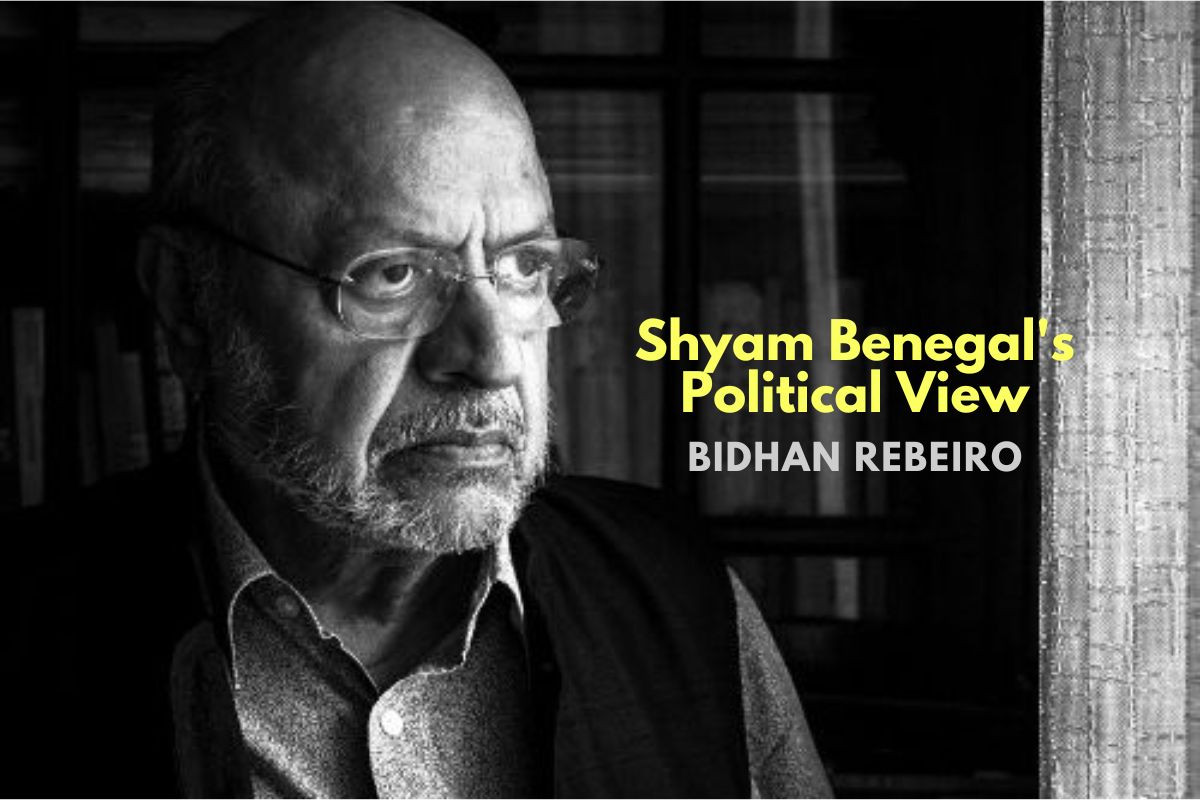
Published: : March 10, 2025, 04:44 PM

Political films emerge when society feels their necessity. A political film, in essence, directly expresses political messages, addresses class and economic disparities, and critiques exploitation and governance. However, all films are political in some way as they reflect certain ideologies.
In India, the so-called song-and-dance-filled, star-studded films often serve as excellent advertisements for capitalist systems. But there exists an alternative. In the 1950s, 60s, and 70s, some Indian filmmakers chose to step away from commercial cinema to create socially and politically conscious films. Among them, Satyajit Ray is often regarded as the foremost figure. Alongside Mrinal Sen, Ritwik Ghatak, and Mani Kaul, another name stands out as a pioneer of Indian "parallel cinema"—Shyam Benegal.
Born on December 14, 1934, in Trimulgherry, a cantonment area in Hyderabad, Shyamsundar Benegal hailed from a middle-class family. His father, Shridhar Benegal, was a photographer with a 16mm camera, which he used to make family films. It was under his father's guidance that Shyamsundar first learned filmmaking.
In his youth, Benegal watched countless films at a nearby cinema hall. Starting his career as a copywriter, he later became one of India's most influential filmmakers. Benegal passed away in the same month he was born—December 23, 2024.
Over his 90-year life, Benegal directed 24 feature films, 41 documentaries, 4 short films, and 6 television productions. This extensive body of work clearly reflects his profound interest in society and politics.
To me, Shyam Benegal represents his magnificent Rural Trilogy—Ankur (1974), Nishant (1975), and Manthan (1976). These three films firmly established his place in Indian cinematic history. While others might mention Bhumika (1977), based on the life of Marathi actress Hansa Wadkar and exploring a woman’s struggles, its political undertones are not as prominent.
In his Rural Trilogy, Benegal highlights collective resistance and becomes a Marxist voice for the oppressed and exploited. Like Marx, he observes society through the lens of two opposing camps—the oppressors and the oppressed.
In Ankur, we see Surya, the son of a zamindar (landlord), sent by his father to oversee a rural estate in Andhra Pradesh. There, he employs Lakshmi, a lower-caste woman, as a cook. Initially, Surya appears kind and tolerant, eating the food prepared by Lakshmi without hesitation. However, it soon becomes clear that his kindness is merely a façade for his lust.
Surya perpetuates the oppressive legacy of his landlord lineage. When Lakshmi becomes pregnant because of him, Surya feels vulnerable before his newlywed wife. Although no one openly speaks about it, everyone understands why Lakshmi is pregnant.
Lakshmi’s mute and unemployed husband, Kishtaiya, struggles with alcoholism. When he approaches Surya for work, the landlord suspects revenge over Lakshmi’s pregnancy and beats him mercilessly. The villagers gather at the scene, fully aware of the situation.
In a bold move, Lakshmi confronts Surya, declaring, “We are not your slaves! We don’t need your work!” Her defiance echoes through the courtyard, embodying the collective spirit of the villagers. In the film’s final scene, after the villagers leave, a young boy throws a stone at Surya’s house, shattering a windowpane before fleeing. The screen turns red—a symbol of the revolutionary red flag.
Based on a true story from Andhra Pradesh, Nishant, written by Vijay Tendulkar, also protests the exploitation and oppression of the feudal system. In this story, a schoolteacher moves to a remote village with his wife and son. The village is ruled by a tyrannical landlord and his three brothers, who take whatever they desire.
The brothers’ eyes fall on the schoolteacher’s wife, Sushila. They abduct and gang-rape her, keeping her captive in their mansion. The teacher desperately tries to rescue his wife, but even the authorities are controlled by the landlord.
The villagers, who respect the teacher, begin to sympathize with him. They also suspect the landlord's involvement in a temple jewelry theft. Initially hesitant, the villagers, mostly poor farmers, are eventually inspired by the teacher to rise against the landlord. A violent uprising ensues, resulting in the destruction of the landlord’s regime and the tragic death of both the oppressors and Sushila.
In the final scene, Sushila’s young son wanders through the devastated mansion, witnessing the aftermath. He eventually runs to the temple, where other children have taken shelter. Nishant portrays how collective resistance can overthrow tyranny, evolving from the subdued rebellion in Ankur.
By the time we reach Manthan, the oppressed rural community is depicted as embracing self-reliance and economic independence. The film showcases a transformative journey, reflecting the idea of the dictatorship of the proletariat.
Set in Gujarat, Manthan follows Dr. Manohar Rao, a veterinarian sent by the government to establish a dairy cooperative in a village. Rao faces resistance from the impoverished Dalit community, exploited by a powerful moneylender. Despite initial struggles, the villagers eventually embrace the cooperative model, gaining confidence and electing their leader, Bhola.
In the final scene, Bhola rallies the villagers, urging them to reject the exploitative system. When no one initially joins him, a young boy steps out of the line and follows Bhola, inspiring others to do the same. Bhola becomes the Pied Piper of a new era, leading the villagers toward a more equitable society.
Benegal’s Rural Trilogy lays bare the conflicts between the ruling class and the oppressed, consistently featuring a young boy in the final scenes. In Ankur, the boy throws a stone; in Nishant, he witnesses the aftermath of revolution; in Manthan, he leads the way to a new socio-economic order.
To me, the boy represents the future—fragile yet capable of rebellion (Ankur), a witness to the cycle of power (Nishant), and a pioneer of change (Manthan).
Benegal’s brilliance lies in his ability to place hope in the future while addressing present crises. His vision of an egalitarian, exploitation-free society is evident in his subsequent works, whether biographical or documentary.
In his later years, Benegal directed Mujib: The Making of a Nation (2023), a Bangladesh-India co-production. While this film lacks the fervor of his Rural Trilogy, it’s understandable, given the physical and mental demands of filmmaking at an advanced age.
Nonetheless, Benegal’s legacy is firmly cemented with his Rural Trilogy. Even if he hadn’t made another film after these three, his place in Indian cinematic history would remain unshakable.
Bidhan Rebeiro is a film critic, essayist, and journalist.